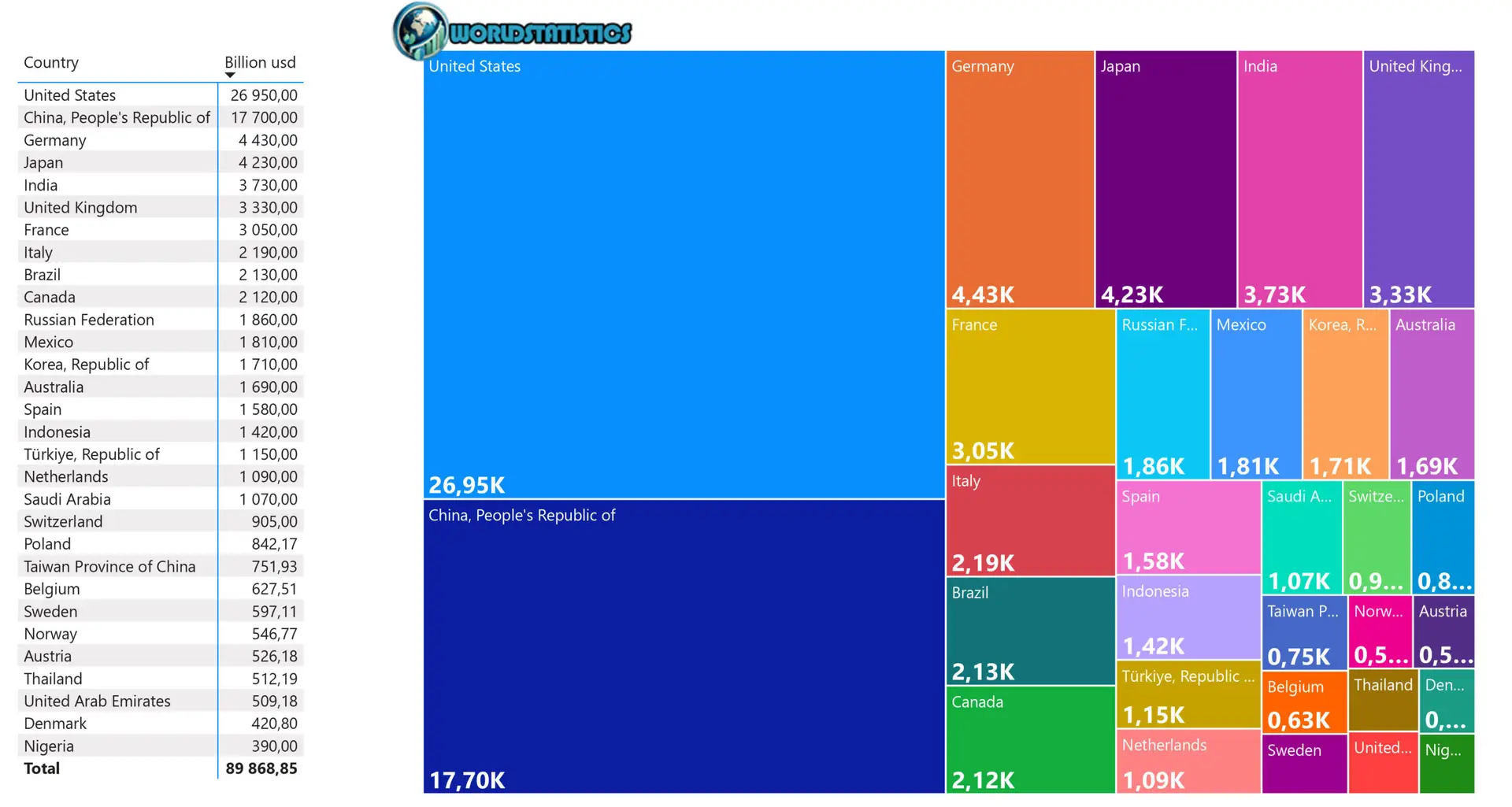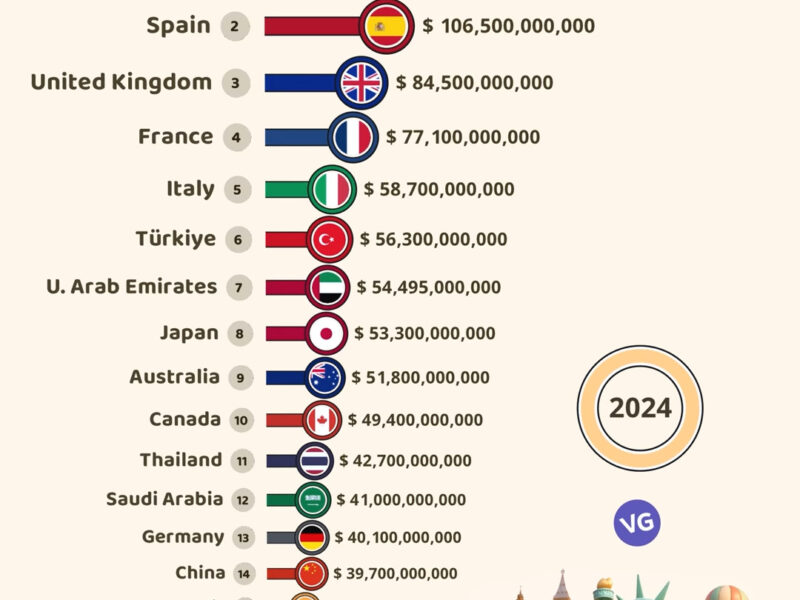https://youtu.be/dpBfUvlmi-4
Studying the world’s largest economies is fascinating for understanding the dynamics of the global economic landscape. Here is a deeper look at the top 30 economies worldwide and their contributions to the global Gross Domestic Product (GDP):
1- United States ($26.95 trillion)
America boasts the world’s largest economy, accounting for about a quarter of global output. It is characterized by technological prowess, robust financial services, and a culture of innovation.
2- China ($17.70 trillion)
The world’s second-largest economy has experienced rapid growth driven by its manufacturing and trade might. China is transitioning towards a more service and innovation-based economy.
3- Germany ($4.43 trillion)
A manufacturing powerhouse, with an economy built on automotive, machinery, and precision engineering sectors. Exports remain a significant part of its economy.
4- Japan ($4.23 trillion)
An advanced economy reliant on high-tech manufacturing, exports, and precision industries. Japan faces demographic and economic headwinds.
5- India ($3.73 trillion)
The world’s fifth-largest economy is rapidly growing, leveraging its massive population and emerging consumer market. Services and technology sectors are driving growth.
6- United Kingdom ($3.33 trillion)
A diverse service-based economy underpinned by its financial sector, business services, and tourism. Brexit has introduced some economic challenges.
7- France ($3.05 trillion)
A highly developed European economy strong in luxury goods, aerospace, and agriculture. It maintains a robust social safety net.
8- Italy ($2.19 trillion)
An industrial economy with strengths in automotive, fashion, machinery, and tourism. Has faced fiscal and banking challenges.
9- Brazil ($2.13 trillion)
Latin America’s largest economy with strengths in agriculture, mining, manufacturing, and services. Economic and political instability remain challenges.
10- Canada ($2.12 trillion)
A highly developed mixed economy with strong service and natural resource sectors. Trade with the U.S. is vital.
11- Russia ($1.86 trillion)
An economy heavily reliant on energy exports but with ambitions to diversify. Geopolitical tensions have impacted its growth.
12- Mexico ($1.81 trillion)
An economy integrated with the U.S. and reliant on manufacturing, tourism, remittances, and oil exports. Regional economic powerhouse.
13- South Korea ($1.71 trillion)
An export-driven economy known for electronics, automotive, shipbuilding, and steel production. A regional economic leader.
14- Australia ($1.69 trillion)
An economy driven by services, mining, agriculture, manufacturing, and construction. Benefitting from trade with China.
15- Spain ($1.58 trillion)
An economy recovering from the Eurozone crisis, strong in tourism, automotive, renewable energy, and agriculture.
16- Indonesia ($1.42 trillion)
A rapidly growing emerging market driven by manufacturing and natural resources. It has an enormous consumer base and young population.
17- Turkey ($1.15billion)
A rapidly industrializing economy, serving as a regional manufacturing hub. Challenged by high inflation and geopolitical tensions.
18- Netherlands ($1.09 trillion)
An open, trade-oriented European economy with strengths in agriculture, energy, logistics, and a business-friendly environment.
19- Saudi Arabia ($1.07billion)
The largest economy in the Arab world, heavily reliant on oil production and exports. Diversifying into tourism, finance, and renewable energy.
20- Switzerland ($905 billion)
One of the world’s wealthiest nations, with a sophisticated services sector including finance and tourism. Known for precision industries and innovation.
21- Poland ($842.17 billion)
Central Europe’s largest economy has seen robust growth driven by manufacturing, services, and a growing domestic market.
22- Taiwan ($751.9 billion)
An advanced, export-oriented economy focused on electronics, machinery, petrochemicals, and services. Home to tech giants.
23- Belgium ($627.51billion):
A diversified service-based economy, with strengths in automotive assembly, chemicals, metals, and logistics. Home to European Union institutions.
24- Sweden ($597.11 billion)
A highly developed, innovative economy with prowess in telecommunications, automotive, pharmaceuticals, and modern services.
25- Norway ($546.77 billion)
Oil and gas production have fueled its prosperity. A model welfare state with high levels of income and quality of life.
26- Austria ($526 billion)
A prosperous economy with robust manufacturing, including machinery, vehicles, and metallurgy. Services and tourism are important.
27- Thailand ($512 billion)
An export-driven economy focused on manufacturing, agriculture, tourism, and automotive production. Hampered by political instability.
28- United Arab Emirates ($509 billion)
A diversified, high-income economy driven by oil exports, aviation, tourism, and financial services. Major regional hub.
29- Denmark ($420 billion)
A highly developed welfare state with strengths in shipping, pharmaceuticals, renewable energy, and a focus on work-life balance.
30- Nigeria ($390 billion)
Sub-Saharan Africa’s largest economy, reliant on oil, services, and agriculture. Rapid population growth and infrastructure deficits remain challenges.
These leading 30 economies, shaped by manufacturing, trade, services, and technology, account for nearly 85% of global GDP. Their diversity continues impacting the trajectory of the world economy.



